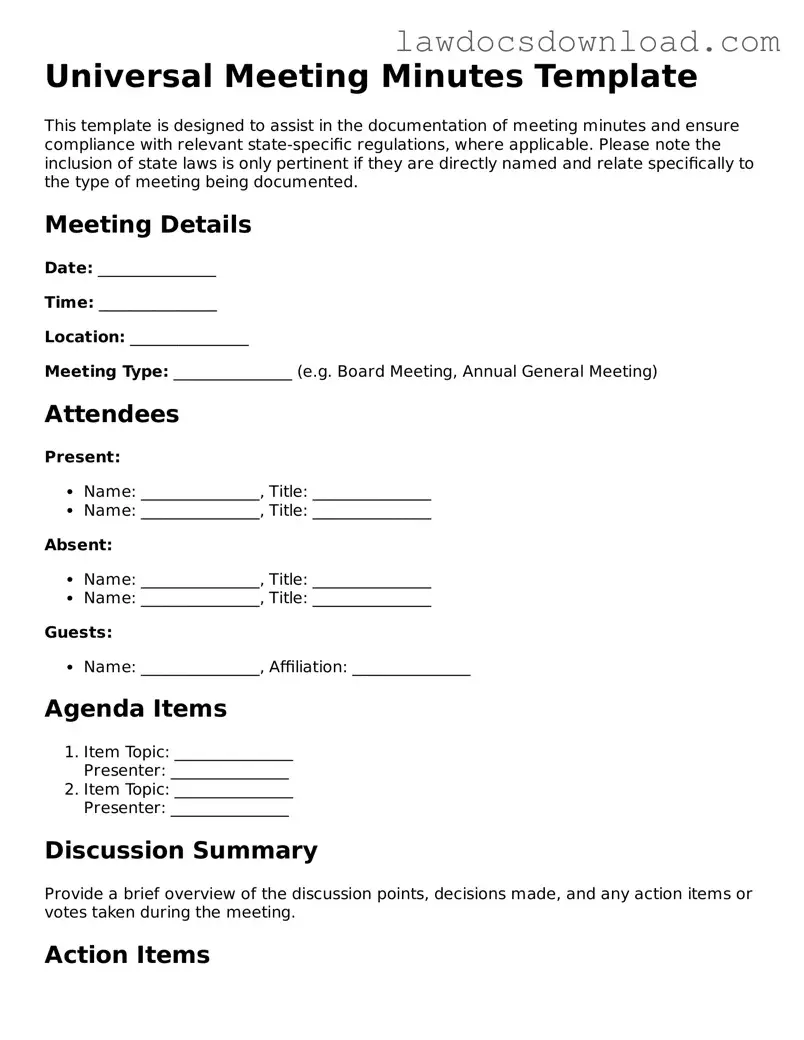The Meeting Minutes form shares similarities with the Corporate Resolution form, primarily in how both documents record decisions made by a company's board of directors or shareholders. Each serves as an official record, detailing who was present, what decisions were made, and any actions agreed upon during a meeting. Where Corporate Resolutions often focus on a specific decision, Meeting Minutes provide a comprehensive record of an entire meeting's proceedings.
Another related document is the Project Meeting Minutes, which, much like the general Meeting Minutes form, documents discussions, decisions, and assigned tasks during a project meeting. The key difference lies in the focus; Project Meeting Minutes are tailored to track the progress and hurdles of a specific project, capturing detailed actions and decisions that drive the project forward.
The Action Items Tracker is akin to the Meeting Minutes form in its function to note decisions and assigned responsibilities. However, it specifically targets the tasks distributed during a meeting, tracking their progress post-meeting. Unlike the broader scope of Meeting Minutes, the Action Items Tracker offers a focused view on the follow-up tasks required to implement decisions made during a meeting.
Meeting Agendas and Meeting Minutes forms are closely connected, with the former setting the outline and expectations of what is to be discussed and the latter detailing what was actually discussed and decided. The Meeting Agenda is used to organize and set the scope of the meeting in advance, while the Meeting Minutes document the outcomes and resolutions achieved during the meeting.
The Consent Agenda is another document related to Meeting Minutes. It streamlines meetings by grouping routine items and non-controversial decisions into a single agenda item. Like Meeting Minutes, it records decisions made by a board or committee. The Consent Agenda differs by allowing for a more efficient meeting process, where items not requiring discussion are approved collectively, instead of being recorded in detail as in traditional Meeting Minutes.
Board Reports, similar to Meeting Minutes, serve as a formal documentation method, providing a summary of activities, decisions, and the financial position of an organization to its board of directors. While Board Reports offer a narrative or analytical perspective on the status of the organization, Meeting Minutes provide a chronological account of discussions and resolutions during board meetings.
The Task Delegation Form, akin to sections of the Meeting Minutes where tasks are assigned, focuses on the distribution of tasks to team members post-meeting. It outlines who is responsible for what and by when, ensuring accountability and clarity in the execution of tasks decided during a meeting. The Task Delegation Form is more specific in nature, concentrating solely on the assignment and tracking of tasks.
Committee Charter Documents and Meeting Minutes both serve governance functions, with the former establishing the purpose, structure, and operating procedures of a committee, and the latter documenting the outcomes of the committee's meetings. Although Committee Charter Documents provide the framework within which meetings are conducted, Meeting Minutes record the actual discussions, decisions, and actions taken within that framework.
Strategic Planning Documents bear resemblance to Meeting Minutes in that both are used to set and record the direction and decisions of an organization. Strategic Planning Documents, however, are more forward-looking, outlining goals, strategies, and action plans for the future, whereas Meeting Minutes record what has occurred in the governance and strategic meetings, including decisions made and strategies affirmed or adjusted.
Lastly, the Workshop Summary Report and Meeting Minutes form are alike in their purpose to summarize and document the proceedings of a session. A Workshop Summary Report focuses on capturing the key points, learnings, discussions, and outcomes of a workshop, making it a valuable tool for attendees and stakeholders. Meeting Minutes, while serving a broader purpose in various meeting contexts, also summarize discussions and decisions, ensuring that those who were not present can stay informed.
